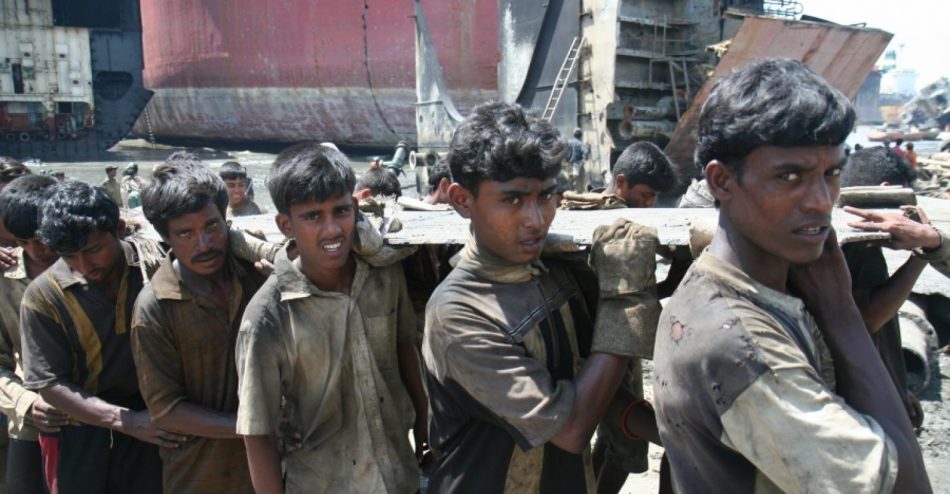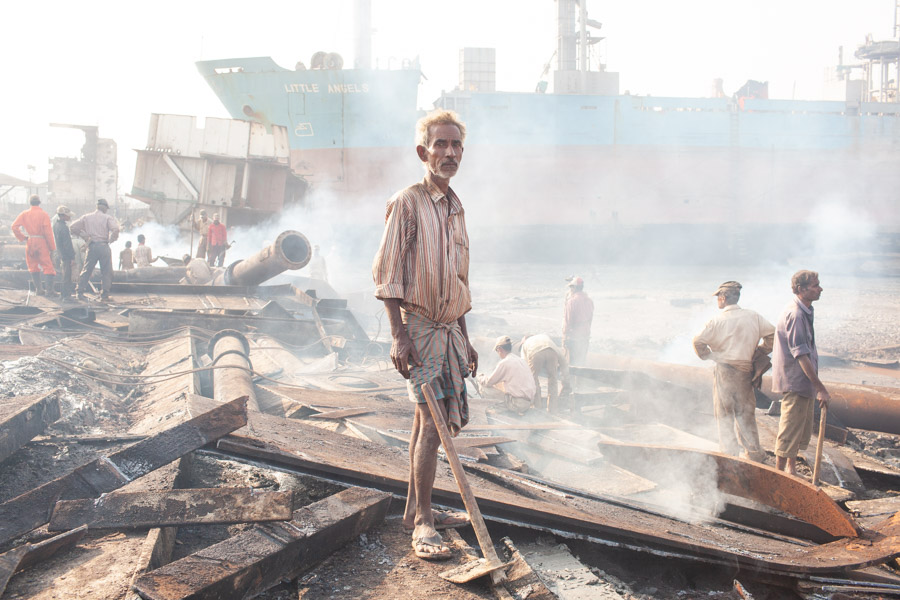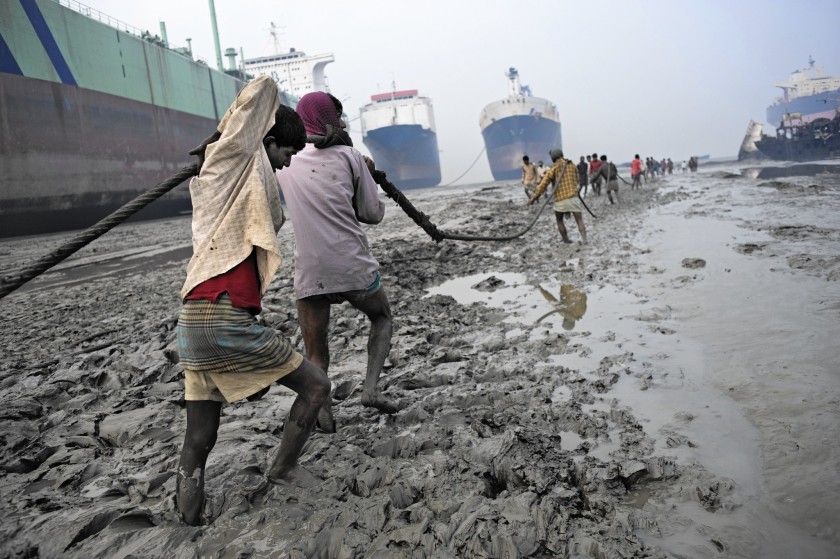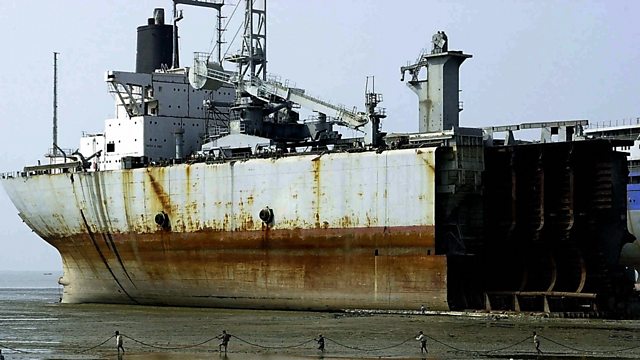
Shipbreaker
A contractor who breaks up old ships for scrap.
‘It was towed up the River Thames from Sheerness in Kent to a ship-breaker’s yard in Rotherhithe, South London.’
Oxford Dictionary





Shipbreaking yards, also known as ship graveyards or ship demolition yards, are facilities where decommissioned or obsolete ships are dismantled and their parts recycled. Here are some key points about shipbreaking yards:
Purpose: The primary purpose of shipbreaking yards is to salvage valuable materials and components from old ships, such as steel, copper, and other metals. These materials can be recycled and used in various industries.
Location: Shipbreaking yards are typically located in coastal areas, close to ports or navigable waterways. This allows for easy access to the ships and facilitates the transportation of salvaged materials.
Environmental Concerns: Shipbreaking can be a hazardous and environmentally damaging process. Many old ships contain toxic materials such as asbestos, lead, and oil residues. The improper handling and disposal of these substances can lead to pollution of the surrounding land, water, and air. Efforts have been made to improve environmental standards in shipbreaking yards.
Safety and Labor Conditions: The shipbreaking industry has been associated with poor safety standards and labor conditions in some regions. Workers in shipbreaking yards are exposed to various risks, including accidents, exposure to toxic substances, and unsafe working conditions. Organizations and regulatory bodies have been working to improve safety measures and protect the rights of workers.
Shipbreaking Process: Shipbreaking involves several stages. Initially, the ship is brought to the yard and assessed for salvageable materials. Hazardous substances are removed, and then the ship is dismantled using various methods, including cutting, torching, and mechanical breaking. The salvaged materials are sorted and sent for recycling or sale.
Economic Impact: Shipbreaking yards can have a significant economic impact on the local communities where they are located. They provide employment opportunities, both directly in the yard and indirectly through associated industries such as transportation and recycling. The sale of salvaged materials also generates revenue.
Regulation and Standards: In recent years, there has been an increased focus on regulating the shipbreaking industry to improve safety, labor conditions, and environmental practices. International organizations, such as the International Maritime Organization (IMO), along with national governments and non-governmental organizations, have established guidelines and standards to govern shipbreaking activities.
Recycling and Sustainability: Shipbreaking yards play a crucial role in recycling and sustainability efforts. By salvaging and recycling materials from old ships, the industry helps reduce the demand for new raw materials and minimizes waste. Proper recycling practices ensure that valuable resources are reused and the environmental impact is mitigated.
It is important to note that practices and conditions in shipbreaking yards can vary widely depending on the location and regulatory framework. While efforts are being made to improve safety and environmental standards, challenges still exist, and further progress is needed to ensure sustainable and responsible shipbreaking practices.
1 Echoes of Ship Breaking
17 jul. 2014
He is one of the 66,000 workers who work on the ship breaking yards at Alang in Gujarat and Darukhana in Mumbai. They migrate from UP, Orissa, Bihar and various other states across India in search of employment and better life. The job of these workers is to strip the raw materials from these ships and sell them to various integral industries i.e. construction, steel mills, to name a few.
The ship breaking industry as always been surrounded with myths and controversies. With many reports in the media mostly giving it a broad tag of “hazardous to environment” which is far from the truth, what ship-breaking actually does is reuse valuable raw materials striped from a dead ship, which would end up being more hazardous if left in the sea.
The primary pressing issue of ship breaking which gets skirted is its workers. The process of ship-breaking requires workers from the start to the end. Often to skirt costs; untrained contractual workers will be hired, safety equipment will be ignored and benefits will be skimmed.
In this documentary ‘Echoes of Ship-Breaking’ we’ll be entering through the backdoor of the ship-breaking industry to see:
• How the industry processes labour and ships
• How ships are brought in and labourers are hired, and how it starts
• The industry’s questionable history regarding worker laws
• Why and how ship breaking reached India
• How ship breaking affects the environment
• Breaking down the process of ship-breaking in India
• Its contribution to India and the future of ship breaking in India
2 The Ship Breakers
3 The Ship Breakers of Bangladesh: VICE INTL
9 feb. 2015
4 Ship Breakers | Bangladesh
16 jul. 2013
Broadcast: 17 February 2013 on Sunday Night, Seven Network, Australia.
It’s one of the most jaw-dropping sights of the modern world. For as far as the eye can see, along a stretch of coastline in Bangladesh, hundreds of mammoth supertankers lie beached on the sand. This is where the world’s ships come to die. Tim joins the thousands of workers, some of them children, who are paid just 47 cents a day to break up these rusting giants with their bare hands.
AWARDS:
Winner: Walkley Award for Camerawork, Australia (2013)
CREW:
Reporter / Camera: Tim Noonan
Producer: Ali Russell
Sound: Dan Abbott
Editor: Jimmy Hamilton
5 The Chittagong Ship Breaking Yard | Journal Reportes
13 jun. 2015
6 Echoes of Ship Breaking
17 jul. 2014
The bothering heat and shouts of his Mukadam mingles with the echoes of machine and men usually 30 to 70 feet below him. He has to silence it all when he turns on his blow torch and focuses solely on weakening the structure of the very ship he stands on; right now he is working on the metal holdings around the mast. He stands away cautiously as the weakened mast is hooked on to a whinge and it’s pulled down. The bulking mast hits the bottom of the hull, the boom reaches his ears and touches his skin, it reminds him a little bit of his village, of his childhood, when he would drop a metal bucket in well to collect water. With no time for nostalgia he gets back to cutting another part of the hull, he does this every day for 8-10 hours; his safety net is his experience.
He is one of the 66,000 workers who work on the ship breaking yards at Alang in Gujarat and Darukhana in Mumbai. They migrate from UP, Orissa, Bihar and various other states across India in search of employment and better life. The job of these workers is to strip the raw materials from these ships and sell them to various integral industries i.e. construction, steel mills, to name a few.
The ship breaking industry as always been surrounded with myths and controversies. With many reports in the media mostly giving it a broad tag of “hazardous to environment” which is far from the truth, what ship-breaking actually does is reuse valuable raw materials striped from a dead ship, which would end up being more hazardous if left in the sea.
The primary pressing issue of ship breaking which gets skirted is its workers. The process of ship-breaking requires workers from the start to the end. Often to skirt costs; untrained contractual workers will be hired, safety equipment will be ignored and benefits will be skimmed.
In this documentary ‘Echoes of Ship-Breaking’ we’ll be entering through the backdoor of the ship-breaking industry to see:
• How the industry processes labour and ships
• How ships are brought in and labourers are hired, and how it starts
• The industry’s questionable history regarding worker laws
• Why and how ship breaking reached India
• How ship breaking affects the environment
• Breaking down the process of ship-breaking in India
• Its contribution to India and the future of ship breaking in India
7 Shipbreakers
8 SHIPBREAKERS Documentary
28 dec. 2021
9 Shipbreaking Bangladesh
4 jan. 2018
10 The Wire Nest…life In Mumbai’s Shipbreaking Yards
24 jan. 2013
11 An environmental disaster: The true cost of cheaply dismantling ships in India
27 jun. 2019
5 sep. 2016
13 Where Ships Go to Die, Workers Risk Everything | National Geographic
16 apr. 2014
14 Bangladesh 2013 Part 1
11 dec. 2015
15 Most Incredible Junkyards in the World
17 feb. 2018
16 RECYCLING CRUISE SHIPS! How & Why Ships Are Scrapped?
21 aug. 2020
Today we’re going to take a look at ship recycling. It may surprise you to learn that most of history’s passenger ships have ended their days at the hand of the cutters torch – including many of the most famous ships that ever set sail.
Ships have ended their days at scrap yards for about as long as ships have been around. Scrapping a ship can be a dangerous activity that requires skill and experience to be carried out successfully.
It allows materials such as steel, aluminium, glass and the like, to be extracted, reused and repurposed. This has led to terms like “it’s been turned into razor blades” becoming common slang for the fate of a ship heading to scrap.
For the most part, ships are withdrawn from service as newer vessels come online to replace them. This is a gradual process – with some ships being retained longer than others due to high demand, or delays in the construction of their replacements.
Most ships that have existed have ended their days in a scrapyard. This includes some of the most famous passenger liners of all time.
While scrap is a common fate for most ships, in recent years cruise ships have been kept in service for longer and longer – thanks to the unprecedented global cruising boom experienced over the past few decades.
This isn’t to say cruise ships haven’t been broken up during this time, with older vessels such as SS Norway – the former Pacific Princess “Love Boat” and the former P&O Pacific Sky all being scrapped over the last two decades.
Costa Victoria, Carnival Fantasy, Carnival Inspiration and Pullmantur’s Sovereign and Monarch have all been sold for scrap in recent months, with the latter four vessels all heading to the same Turkish scrapyard.
It might surprise you though that the majority of the things on board the ship, such as dining tables and chairs, beds, lighting and carpets are left aboard and either on-sold or recycled by the scrap yard.
While ships like Canberra, Big Red Boat II, Carnival Fantasy, Carnival Inspiration, Sovereign and Monarch sailed to scrap wearing their original name and livery, in some cases ships bound for the scrap yard may be renamed and de-branded before their final voyage.
For example, the SS Norway was renamed Blue Lady before she made her final journey to Alang. Norwegian Cruise Line branding was removed from the ship in advance of her final voyage.
While the media attention has been grabbed with dramatic footage of cruise ships being driven up onto the beach under their own power – this is not always the case. Norway, for example, was taken under tow owing to her engines being unserviceable after an on board explosion – which was actually the cause of her exit from service.
More recently this was seen with the Costa Concordia. Having been partially re-floated, the ship was towed to Genoa in Italy where she was dismantled.
Some ships are harder to scrap than others, which can make the process very drawn out, as was the case with the Canberra. Some yards will commence the process with a ceremonial ‘cutting off the bow’, which we’ve seen occur on the Monarch in Turkey.
My thanks to:
Peter Knego / http://midshipcentury.com for remarkable video footage used in this video of the ships being scrapped at Alang. Peter has videos including “The Sands of Alang” which you can check out: https://midshipcentury.com/
Andrew Sassoi-Walker https://www.solentphotographer.com/ – Andrew is without doubt one of the finest photographer of cruise ships and aircraft!
Rob Henderson & Doug Cremer for access to the Henderson & Cremer Collection.
J. Frame & Vicki Cross for photographs.
17 The Dark side of the Shipping Industry – Ship Breakers
17 apr. 2013
18 Supertanker FRONT DRIVER beaching itself at Gadani Pakistan.
19 How $300 Million Cruise Ships Are Demolished | Big Business
16 mei 2021
20 These are the Cruise Ships Scrapped in 2020/2021
12 jan. 2021
00:00 Why are cruise lines selling ships?
01:40 Carnival Corporation ships sold
04:10 Royal Caribbean ships sold
06:20 CMV Ships sold
06:59 Other cruise ships sold
07:25 How are cruise ships scrapped?
08:57 Is it better for the environment to scrap old ships?
21 How The Shipping Industry Is Turning Bangladesh Toxic | Earth Stories
Back to menu IMPORTANT CONTENT
22 Toxic tanker demolished on Indian beach
Back to menu IMPORTANT CONTENT
23 Shipbreakers
21 jun 2017
As visually mesmerizing as it is compelling, Shipbreakers takes the viewer into the heart of Alang, India, a vibrant shantytown where 40,000 people live and work in the most primitive conditions.
Since the early ’80s, the rusting hulks of thousands of the world’s largest ships have been driven onto the remote beaches of Alang, off the Arabian Sea, to be dismantled, piece by piece. Sold for scrap, the ship owners rarely bother to abide by the UN Basel Convention, which bans shipments of transboundary waste. One worker a day, on average, dies on the job, some from explosions or falls, but many will contract cancers caused by asbestos, PCBs and other toxic substances.
Shipbreakers vividly captures both the haunting beauty of the ships and the deplorable conditions of the workers–in an unforgettable portrayal where Third World ingenuity meets 21st century global economics.
Directed by Ed Barreveld, Ted Biggs and Michael Kot – 2004 | 73 min
Shipping’s Dirty Secret
File on 4
The shipping industry is worth millions to the British economy and we depend on it for most of our goods. File on 4 lifts the lid on the dangerous and polluting world of shipbreaking and investigates why ships once owned by UK companies end their lives on beaches in India, Pakistan and Bangladesh.
Editor, Maggie Latham
Producer, Jim Booth
Reporter, Kate West
Ship scrappage and global trade
Business Daily
We examine some of the less glamorous minutiae of global trade – like where old ships go to die, and who clears up the mess afterwards. We have a report from the ship-wrecking yards of Bangladesh.
And we shine a light on that little square thing they place under heavy crates of stuff to lift them on and off lorries. Could the humble pallet in fact be the single most important object in the global economy? Marshall White, director of the Pallet & Container Research Laboratory at Virginia Tech University, thinks it might be.
Plus the scourge of the license. The USA may have a reputation as the champion of unregulated commerce, but some 30% of its workforce require specialist licenses to work their trade, and our regular commentator Steve Fritzinger argues that such restrictions, put there in the name of consumer-protection, often border on the ridiculous.
(Image: A ship-breaking yard in Chittagong, Bangladesh. Credit: FARJANA K. GODHULY/AFP/Getty Images)

Shipbreaking yards, also known as ship graveyards or ship dismantling yards, are facilities where decommissioned or old ships are dismantled for the purpose of recycling their components and materials. Here are some key points about shipbreaking yards:
Ship Dismantling Process: Shipbreaking yards specialize in the dismantling of ships, including commercial vessels, naval ships, and oil tankers, that have reached the end of their operational lives or have become uneconomical to repair or maintain. The process involves breaking down the ships into smaller sections and recycling or disposing of various components.
Location: Shipbreaking yards are typically located in coastal areas, often in developing countries, where labor and environmental regulations may be less stringent compared to developed nations. This enables cost-effective dismantling due to lower labor and operational costs.
Economic Importance: Shipbreaking yards play a significant role in the local economies of the regions where they are located. They provide employment opportunities for thousands of workers, often in areas with limited job prospects. The dismantling activities also generate revenue through the sale of salvaged materials, such as steel, copper, and other valuable metals.
Environmental and Safety Concerns: Shipbreaking yards face numerous environmental and safety challenges. Ships may contain hazardous materials like asbestos, heavy metals, PCBs (polychlorinated biphenyls), and oil residues. Improper handling and disposal of these substances can lead to severe pollution and health risks for workers and the surrounding environment. Efforts have been made to improve safety and environmental standards in shipbreaking yards.
Regulations and Standards: In recent years, international regulations and standards have been established to address the environmental and safety concerns associated with shipbreaking. The International Maritime Organization (IMO) developed the Hong Kong International Convention for the Safe and Environmentally Sound Recycling of Ships, which sets guidelines for the proper disposal and recycling of ships. However, implementation and enforcement of these standards remain a challenge.
Shipbreaking Industry Reforms: There has been increasing pressure on the shipbreaking industry to adopt safer and more environmentally friendly practices. Some ship owners are choosing to sell their decommissioned vessels to yards that prioritize worker safety and environmental protection. Furthermore, there are initiatives to promote greener ship design and construction, making ships easier and safer to dismantle in the future.
Social Impact: Shipbreaking yards often employ a large number of low-skilled workers, including migrant laborers, who work in hazardous conditions for long hours and low wages. The industry has faced criticism for poor working conditions, lack of safety measures, and worker exploitation. Efforts are being made to improve labor rights and working conditions in shipbreaking yards.
Overall, shipbreaking yards are important for the recycling of old ships and the recovery of valuable materials, but they also face significant challenges related to environmental pollution, worker safety, and labor rights. Ongoing efforts are being made to address these concerns and improve the sustainability of shipbreaking practices.
24 The Scariest Prank Ever
12 okt. 2016